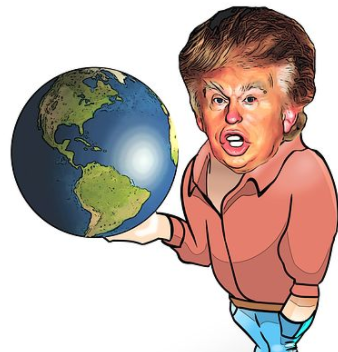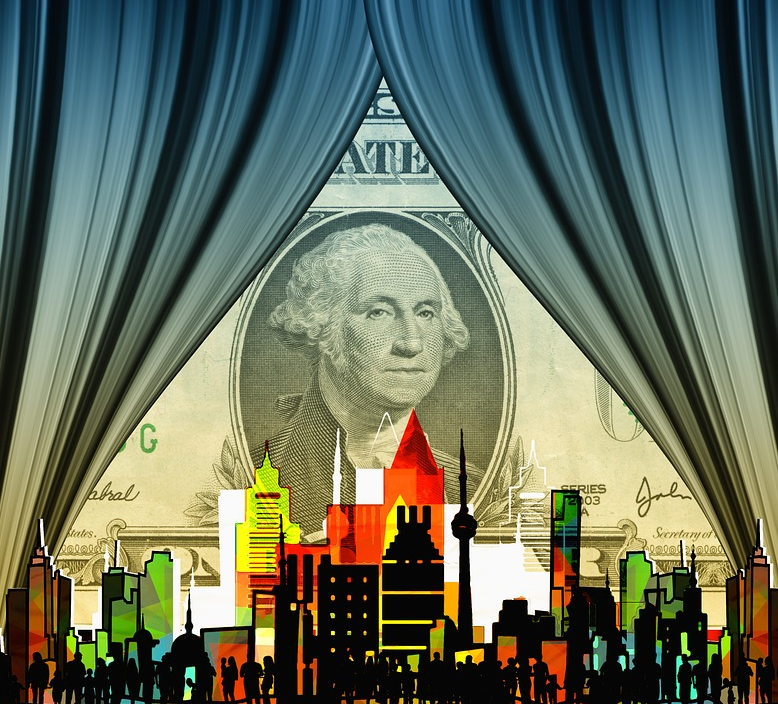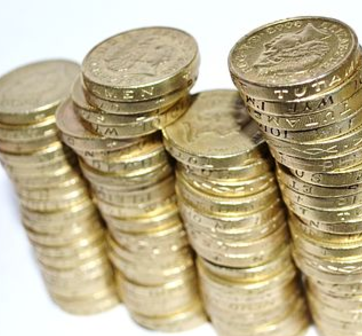I had the good fortune of visiting with my friend John Rubino from Dollar Collapse last weekend, and that led to our newest interview in which we discuss the likely effects of Donald Trump's plans to stimulate the economy and "make America great again." What happens when borrowing and spending get kicked into high gear? John shares some investing ideas to help protect against the probable outcome, the eventual devaluation of the dollar. ~ Ilene
****
Ilene: What are your investing expectations and premises now that we know that Donald Trump has been elected president? Have any of your premises changed as a result?
 John: Trump is looking like Obama/Bush on steroids. That is, even higher government spending, more aggressive and experimental monetary policy and more encouragement for individuals and businesses go borrow and spend.
John: Trump is looking like Obama/Bush on steroids. That is, even higher government spending, more aggressive and experimental monetary policy and more encouragement for individuals and businesses go borrow and spend.
There was a time when stuff like this worked. In the 1950s the Eisenhower administration built the interstate highway system to give jobs to the soldiers returning from the Korean war. And in the 1980s Ronald Reagan cut taxes and increased defense spending. The result in both cases was favorable: strong growth and minimal inflation. But these two presidents enjoyed rock-solid balance sheets and the US had minimal debt and plenty of savings when they started their terms. Today the story is completely different. We’ve been borrowing excessively for four decades and now owe far more than we can ever hope to pay off. Because of this, the “marginal productivity of debt” – that is, the amount of new wealth we can create with each new dollar of debt – has plunged to around zero.
In other words, if we borrow yet another ten trillion dollars, all we’ll do is dig ourselves a deeper hole. And this will remain the case until, one way or another, this debt is wiped out. Either we’ll have a 1930s style deflationary depression in which debt is wiped out through default or we’ll inflate it away via a Weimar Germany-style inflation. Both scenarios will be disastrous for the average person.
So no, my premise – that today’s debt guarantees a crisis and governments will respond by trying to devalue their currencies, which is great for gold and silver – hasn’t changed. In fact it’s gotten stronger with the election of a president whose main policy is a massive increase in borrowing and spending.
Ilene: You previously wrote, "Combine [rising interest rates] with the expectation that President Trump will embark on a spending/tax cutting spree that puts previous administrations to shame, and you get serious demand for dollars and a soaring exchange rate. The dollar index, which measures the USD versus a basket of other currencies, is now at its highest level in a really long time."
Can you discuss how the increased spending and tax cutting will increase the strength of the dollar? It seems counter-intuitive to me. But that is what is happening.
John: It’s a short-term effect. The markets see the US aggressively borrowing and spending and expect that to boost “growth” in the next few years. This makes US assets relatively attractive for traders, since more spending might boost domestic demand for stocks, bonds and real estate.
 But the gain won’t be worth the eventual pain. All the extra debt we’ll have to take on to generate even modest growth will have to be paid off somehow, and that will require an aggressive devaluation of the dollar. So…today’s strong dollar will give way to currency crisis in the future.
But the gain won’t be worth the eventual pain. All the extra debt we’ll have to take on to generate even modest growth will have to be paid off somehow, and that will require an aggressive devaluation of the dollar. So…today’s strong dollar will give way to currency crisis in the future.
It’s important to note that the rest of the world is even further down this path than the US. China quintupled its debt in the six years following the 2008-2009 crisis and is now, by some measures, the most indebted country in the world. Japan’s government debt is the world’s highest compared to the size of its economy. And Europe’s unfunded liabilities – that is, what it owes its retirees – are by themselves enough to bankrupt France, Italy, and maybe even Germany. So it’s not just a US problem. The entire developed world is heading off the same cliff at an accelerating rate.
Ilene: As you noted, higher interest rates and a soaring dollar act as a tax increase on US exporters, which theoretically should lower their sales revenue and lower their share prices. This should, presumably, have a negative effect on many US stocks. Although so far, we've seen the opposite. How would these factors affect gold? In that you are bullish on gold, do you expect a strong move higher in gold to occur after stocks and/or the dollar begin to weaken?
John: Gold and silver benefit from uncertainty. And since the guaranteed outcome of current policy is some form of chaos, it’s a safe bet that terrified capital will start pouring into precious metals in the not too distant future.
Right now we’re just experiencing the typical honeymoon of a new administration. Everyone sees the possibilities of a new policy mix, while the downsides will only become apparent later. For instance, spiking interest rates are being ignored at the moment but higher mortgage rates are already crushing refis and will soon impact home sales. Car loans are getting more expensive – at a time when defaults are already soaring — and bond funds have lost $1 trillion in just the past two months. Meanwhile, as you noted, a soaring dollar makes US products more expensive on foreign markets which will, other things being equal, cut corporate profits. So lots of problems are already emerging. Soon they’ll become headline news, setting off what might become a selling panic in stocks and bonds.
 But it’s important to understand that this will lead the Fed to join the other major central banks in buying equities. A terrible thing to do because it distorts the market’s price signaling mechanism, it will still be seen as the best way to “stabilize” stock prices and therefore the economy. In other words, we’re not though with experimental policies that make things worse rather than better. At least one more iteration will take place in 2017, and that will set the stage for what could well be an epic crisis as the whole house of cards finally comes tumbling down.
But it’s important to understand that this will lead the Fed to join the other major central banks in buying equities. A terrible thing to do because it distorts the market’s price signaling mechanism, it will still be seen as the best way to “stabilize” stock prices and therefore the economy. In other words, we’re not though with experimental policies that make things worse rather than better. At least one more iteration will take place in 2017, and that will set the stage for what could well be an epic crisis as the whole house of cards finally comes tumbling down.
Ilene: What are some of your best investment ideas for preparing for what’s coming?
John: If precious metals are going to be the eventual winners in a world of aggressive currency devaluation, then obviously, it’s important to replace fiat currency cash with gold and silver coins as the risk-free part of one’s portfolio. So the first thing to do is find a trustworthy dealer, get some coins (preferably by dollar-cost averaging — that is, buying a little each month rather than everything all at once), store them safely and then forget about them. They’ll hold their value over long periods of time while fiat currencies are evaporating.
 Then consider gold and silver mining stocks. They’re extremely cheap right now, which means the best of them will soar when things really get going. One interesting strategy for building a portfolio of big, solid miners is to write puts on them. A put is an option (i.e., a financial contract) that gives someone else the right to force you to buy a stock at a lower price, called the strike price. The person buying the put gives you money up front, which you get to keep if the stock doesn’t fall to the strike price. Here’s a real world example:
Then consider gold and silver mining stocks. They’re extremely cheap right now, which means the best of them will soar when things really get going. One interesting strategy for building a portfolio of big, solid miners is to write puts on them. A put is an option (i.e., a financial contract) that gives someone else the right to force you to buy a stock at a lower price, called the strike price. The person buying the put gives you money up front, which you get to keep if the stock doesn’t fall to the strike price. Here’s a real world example:
Let’s say you like Royal Gold (RGLD), a high-quality “streaming” company that invests in developing mines in return for a portion of those mines’ eventual output. RGLD closed on Friday Dec. 9, 2016, at $67.02. If you'd be okay with buying RGLD at around $59 (about 12% lower than its Dec. 9 close), consider selling (writing) an April 21, 2017, $65 strike price put for about $6 per share. That short put position would obligate you to buy 100 shares of RGLD for $65 at expiration if RGLD is trading under $65 per share making your worst case scenario a forced purchase at a net price of $59 ($65 strike price minus $6 put premium). Your maximum profit would be $600 per 100-share contract. It will be achieved if RGLD remains above $65 on expiration date.
If the shares get "put" to you, you can then write covered calls on them, which obligates you to sell the stock if it rises, in return for upfront cash payments. In this way you generate cash – sometimes a considerable amount of cash – each month.
For pure capital gains the junior miners are risky but have massive upside potential. The best of them will soar when gold and silver start gapping up. But you’ll need expert help to separate the 10% likely winners from the 90% probable losers. So subscribe to a good newsletter that specializes in this sector and read it carefully.
Ilene: Thanks, John, always a pleasure.
For more of John's thoughts on the economy, the markets, and on gold, please visit John at his website, Dollar Collapse.
****
Originally published at Phil's Stock World. Pictures via Pixabay.
John Rubino manages the popular website DollarCollapse.com. He is co-author, with GoldMoney’s James Turk, of The Money Bubble (DollarCollapse Press, 2014) and The Collapse of the Dollar and How to Profit From It (Doubleday, 2007), and author of Clean Money: Picking Winners in the Green-Tech Boom (Wiley, 2008), How to Profit from the Coming Real Estate Bust (Rodale, 2003) and Main Street, Not Wall Street (Morrow, 1998). After earning a Finance MBA from New York University, he spent the 1980s on Wall Street, as a Eurodollar trader, equity analyst and junk bond analyst. During the 1990s he was a featured columnist with TheStreet.com and a frequent contributor to Individual Investor, Online Investor, and Consumers Digest, among many other publications. He currently writes for CFA Magazine. John is a frequent contributor to Phil's Stock World.



